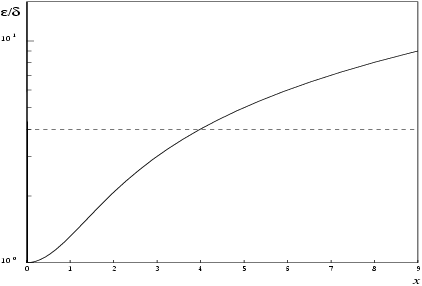NAG Library Function Document
nag_sinh (s10abc)
1 Purpose
nag_sinh (s10abc) returns the value of the hyperbolic sine, .
2 Specification
| #include <nag.h> |
| #include <nags.h> |
| double |
nag_sinh (double x,
NagError *fail) |
|
3 Description
nag_sinh (s10abc) calculates an approximate value for the hyperbolic sine of its argument,
.
For
it uses the Chebyshev expansion
where
.
For
where
is a machine-dependent constant, details of which are given in the
Users' Note for your implementation.
For , the function fails owing to the danger of setting overflow in calculating . The result returned for such calls is , i.e., it returns the result for the nearest valid argument.
4 References
Abramowitz M and Stegun I A (1972) Handbook of Mathematical Functions (3rd Edition) Dover Publications
5 Arguments
- 1:
x – doubleInput
On entry: the argument of the function.
- 2:
fail – NagError *Input/Output
-
The NAG error argument (see
Section 3.6 in the Essential Introduction).
6 Error Indicators and Warnings
- NE_INTERNAL_ERROR
-
An internal error has occurred in this function. Check the function call and any array sizes. If the call is correct then please contact
NAG for assistance.
- NE_REAL_ARG_GT
-
On entry, .
Constraint: .
The function has been called with an argument too large in absolute magnitude. There is a danger of overflow. The result returned is the value of at the closest argument for which a valid call could be made.
7 Accuracy
If
and
are the relative errors in the argument and result, respectively, then in principle
That is the relative error in the argument, , is amplified by a factor, approximately . The equality should hold if is greater than the machine precision ( is a result of data errors etc.) but, if is simply a result of round-off in the machine representation of , then it is possible that an extra figure may be lost in internal calculation round-off.
The behaviour of the error amplification factor can be seen in the following graph:
Figure 1
It should be noted that for
where
is the absolute error in the argument.
8 Parallelism and Performance
Not applicable.
None.
10 Example
This example reads values of the argument from a file, evaluates the function at each value of and prints the results.
10.1 Program Text
Program Text (s10abce.c)
10.2 Program Data
Program Data (s10abce.d)
10.3 Program Results
Program Results (s10abce.r)

